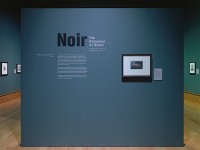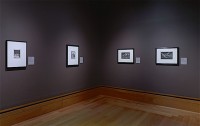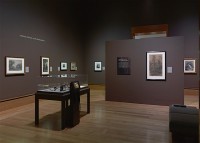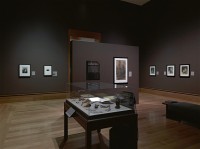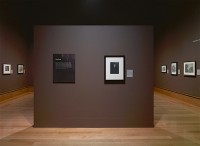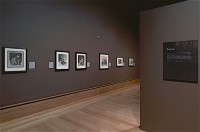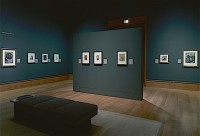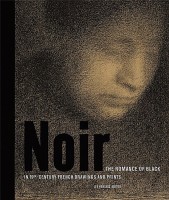The browser will either open the file, download it, or display a dialog.
Noir: The Romance of Black in 19th-Century French Drawings and Prints
J. Paul Getty Museum at the Getty Center, Los Angeles
February 9 – May 15, 2016
Catalogue:
Lee Hendrix, ed.
Noir: The Romance of Black in 19th-Century French Drawings and Prints.
Los Angeles: Getty Publications, 2016.
174 pp.; 111 illus.; bibliography; index.
$39.95
ISBN: 1606064827
With the Noir exhibition and accompanying catalogue, Lee Hendrix, former Curator of Drawings at the Getty Museum, examined an area that had not been explored previously—the ways in which artists in France used black as a means of experimenting in their prints and drawings in the nineteenth century. Pulling together numerous examples from the Getty Museum collections, other local museums and private collectors, Hendrix provided an extremely solid introduction into the ways that various artists from different backgrounds used black in their works (fig. 1). Without focusing on whether the artists were members of the avant-garde, or representatives of a more conservative tradition, the exhibition concentrated on how the media was employed without risking the pitfall of labeling artists as progressive or not. The result was an astounding array of artists whose work shed the usual techniques of handling the medium, including the exploration of the textures of the papers that were employed, to interpret their new creativity.
What made the exhibition most exciting was the way in which it was arranged in the Getty galleries. By selecting themes that carried across artistic groups, Hendrix subtly involved the viewer in actually looking at the different ways in which artists worked. The first section “Prelude: Dark Romanticism” heavily relied on the great names of the romantic movement: Francisco de Goya, Eugène Delacroix, and Théodore Géricault. Each object selected demonstrated how these artists used black to establish mood and deeply personal subjectivity. The use of Goya’s prints made it clear that black had been employed earlier in history, thereby establishing a matrix out of which emerged the challenging innovations of the nineteenth century (fig. 2).
With the second thematic section Hendrix focused on the rise of independent landscape drawing and on the etching revival that began in the 1850s and continued with the support of entrepreneur Alfred Cadart in the 1860s (fig. 3). While the work of Camille Corot (1796–1875) assumed a significant role, Hendrix also examined the far less well-known charcoal drawings of Auguste Allongé (1838–98) and the subtle environments studied by Maxime Lalanne (1827–86) in sites most likely linked to the region near Bordeaux where he had a villa. Lalanne’s dark etching of the demolition of the Rue des Marmousets Quartier de la Cité of Paris is one of his best known works. This example, completed with the patronage of Alfred Cadart, helped establish Lalanne as a highly competent etcher eager to portray the changes in the Parisian landscape. Lalanne’s subtle charcoal drawings of the environment are deserving of more attention than they have received, especially the ways in which he captured nuances of light in an almost proto-Impressionist manner. Completing this area of the exhibition were delicate studies by Adolphe Appian (1818–98), whose isolated regional marshes and ponds continually revealed how tones of charcoal had been utilized to convey atmospheric effects previously seldom attempted.
This section demonstrated how large scale finished landscape drawings came into their own at this time. Artists who worked this way were called fusainistes; their works were called fusains—a new category of creativity that did two things. First it established the importance of the independent fusain as a completed work in itself, not a preparation for something else. Second, the use of fixative, at various states of a drawing’s development, aided an artist in preserving the effects achieved so that they would not be lost if the drawing were moved or worked on in other areas. The fusain, in mellow tones of black, was now a category sought after by collectors who saw this technique as a startling new development that expanded the importance of drawing. Included in this section of the show was an instructional table that provided some of the ways in which the tools of the medium were being used; in this way a visitor could grasp how the effects in drawings were actually done (fig. 4).
In the next section of the exhibition Hendrix focused on Realist compositions, another area that has received little attention. From the moment a visitor came up against the powerful face of a female figure by Théodule Ribot (1823–91) it was apparent that the exhibition had found a rich area of investigation (fig. 5). Ribot’s contributions to Realism have been largely overlooked as his work is usually too forceful, too exacting for people to collect or easily understand. As an advocate of earthy themes, Ribot’s treatment of light created effects more appropriate in the seventeenth century than in the nineteenth, creating an aura around the artist that suggested he was too closely linked to the past. To think in these terms, however, is to miss the expressionistic strength of Ribot’s best work. Gustave Courbet (1819–77) was represented in the exhibition by the head of a young bacchante, a work also attesting to the strength of his vision. But it was the works by artists lesser known such as François Bonvin, Charles Milcendeau, or P. A. J. Dagnan-Bouveret that emphasized the depth of this section (fig. 6). The utilization of themes drawn from everyday life, the directness of approach, and the forceful way in which the medium was employed made this segment stand out. By placing the works of Honoré Daumier and Edouard Manet in this area, Hendrix also added contextual importance to a movement of artists working directly, handling a medium with a roughness that reinforced their interest in visualizing themes that did not emphasize what was pretty. With this attitude, a new sense of individuality emerged.
In reaching the fourth section, “Fantasy and Dreams,” the ways in which many artists provided visualization for their unusual perceptions remained paramount (fig. 7). In the case of creators such as Félix Bracquemond or Rodolphe Bresdin, their inclusion, at least from the works selected, seemed somewhat strained, but once examination of the works of Odilon Redon (1840–1916) began this section was in clearer, firmer territory. Whether his works are fully Symbolist or not remains a moot point. What is apparent is that Redon’s insistence on having his unusual forms emerge from darkness added to the sense of mystery. This quality was further heightened by the inclusion of works by Henri Guérard, (1846–97) an artist who remained one of the most original figures in the show. Having images that emphasized the creative ways in which artists worked with a medium further enriched one of the primary goals of the exhibition.
With the final section the show achieved one of its most salient points: how the optics of shadow underscored the creative potential of the use of black. Here, with works by Georges Seurat, Albert-Charles Lebourg, Félix Buhot, Charles Angrand, and Edgar Degas, the images selected demonstrated the highly experimental approaches of many artists. Charcoal, etching, black crayon, and conté crayon reinforced the general interest in breaking from tradition to try new approaches in the name of allowing new tendencies to emerge. And the effect of this approach—at the end of the show—revealed most effectively that in this area the exhibition’s goals were realized. While the aims of the show were apparent to those who knew the material and many of the artists beforehand, it’s not certain that these goals were clear to everyone. This is where the exhibition broke down.
Increasing the range of artists is certainly commendable and necessary for the nineteenth century, but the exhibition, as an exhibition on the walls of the Getty, needed more explication to help guide a viewer to understand all the intricacies implied. Much explanation, however, was contained in the excellent catalogue of the show where the techniques were fully explained (fig. 8). The importance of the renaissance of interest in the use of charcoal was fully examined, providing readers with the necessary background to appreciate the exhibition. This was undoubtedly a rare exhibition. But the deeper implications of black remain elusive. What are the fuller societal implications? Why was black the dominant tone of so many works? Only another exhibition going more deeply into the context of the times can do this. Noir was only the start.
Gabriel P.Weisberg
University of Minnesota
vooni1942[at]aol.com


